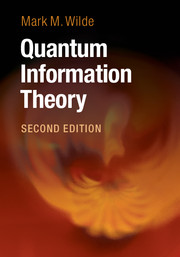Book contents
- Frontmatter
- Contents
- Preface to the Second Edition
- Preface to the First Edition
- How To Use This Book
- Part I Introduction
- Part II The Quantum Theory
- Part III Unit Quantum Protocols
- Part IV Tools of Quantum Shannon Theory
- Part V Noiseless Quantum Shannon Theory
- Part VI Noisy Quantum Shannon Theory
- Appendix A Supplementary Results
- Appendix B Unique Linear Extension of a Quantum Physical Evolution
- References
- Index
How To Use This Book
Published online by Cambridge University Press: 16 February 2017
- Frontmatter
- Contents
- Preface to the Second Edition
- Preface to the First Edition
- How To Use This Book
- Part I Introduction
- Part II The Quantum Theory
- Part III Unit Quantum Protocols
- Part IV Tools of Quantum Shannon Theory
- Part V Noiseless Quantum Shannon Theory
- Part VI Noisy Quantum Shannon Theory
- Appendix A Supplementary Results
- Appendix B Unique Linear Extension of a Quantum Physical Evolution
- References
- Index
Summary
For Students
Prerequisites for understanding the content in this book are a solid background in probability theory and linear algebra. If you are new to information theory, then there should be enough background in this book to get you up to speed (Chapters 2, 10, 13, and 14). However, classics on information theory such as Cover & Thomas (2006) and MacKay (2003) could be helpful as a reference. If you are new to quantum mechanics, then there should be enough material in this book (Part II) to give you the background necessary for understanding quantum Shannon theory. The book of Nielsen & Chuang (2000), sometimes affectionately known as “Mike and Ike”, has become the standard starting point for students in quantum information science and might be helpful as well. Some of the content of that book is available in the dissertation of Nielsen (1998). If you are familiar with Shannon's information theory (at the level of Cover & Thomas, 2006, for example), then the present book should be a helpful entry point into the field of quantum Shannon theory. We build on intuition developed classically to help in establishing schemes for communication over quantum channels. If you are familiar with quantum mechanics, it might still be worthwhile to review Part II because some content there might not be part of a standard course on quantum mechanics.
The aim of this book is to develop “from the ground up” many of the major, exciting pre- and post-millennium developments in the general area of study known as quantum Shannon theory. As such, we spend a significant amount of time on quantum mechanics for quantum information theory (Part II), we give a careful study of the important unit protocols of teleportation, super-dense coding, and entanglement distribution (Part III), and we develop many of the tools necessary for understanding information transmission or compression (Part IV). Parts V and VI are the culmination of this book, where all of the tools developed come into play for understanding many of the important results in quantum Shannon theory.
- Type
- Chapter
- Information
- Quantum Information Theory , pp. xv - xviiiPublisher: Cambridge University PressPrint publication year: 2017



